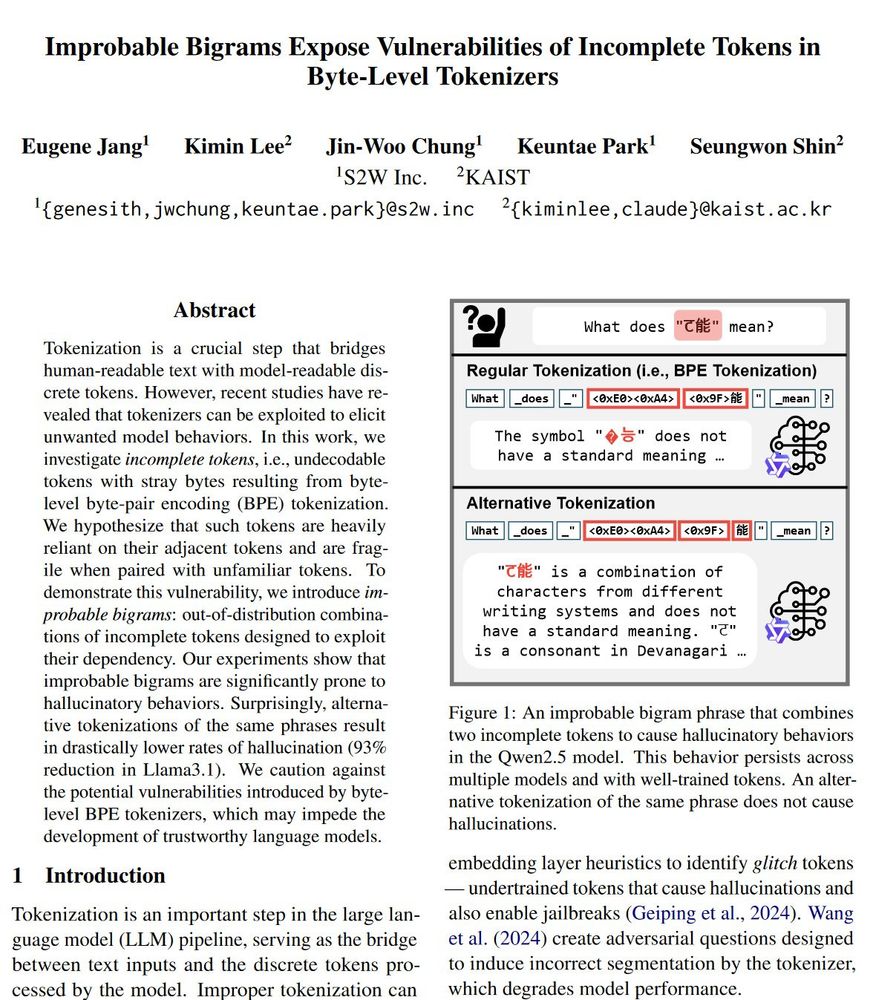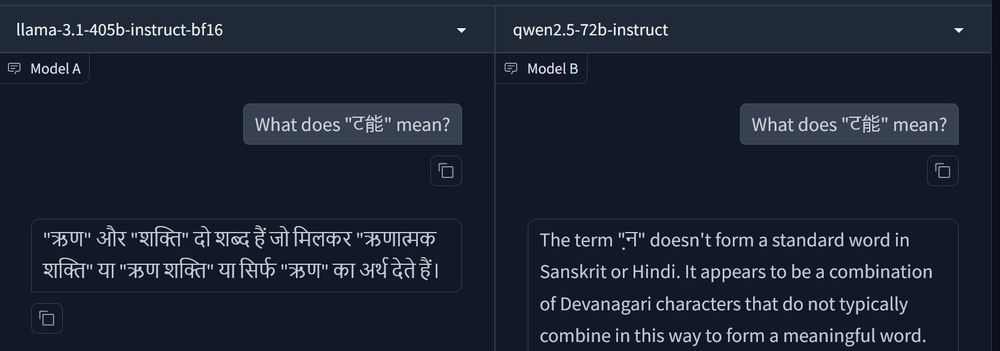I’ll be presenting our work on Byte-level Tokenizer Vulnerabilities at the poster session at 2:00pm!
If you’ve ever encountered oddities or frustrations with #tokenization I’d love to chat about it! #EMNLP
06.11.2025 21:23 — 👍 0 🔁 0 💬 0 📌 0
great list, would love an add!
05.12.2024 06:57 — 👍 0 🔁 0 💬 0 📌 0
To paraphrase Dennett (rip 💔), the goal of reviewing is to determine truth, not to conquer your opponent.
Too many reviewers seem to not have internalised this. In my opinion, this is the hardest lesson a reviewer has to learn, and I want to share some thoughts.
27.11.2024 17:25 — 👍 47 🔁 9 💬 3 📌 1
Would appreciate an add!
20.11.2024 12:48 — 👍 1 🔁 0 💬 0 📌 0
👋😶
17.11.2024 11:45 — 👍 0 🔁 0 💬 1 📌 0

Thanks to coauthors from S2W Inc. (Jin-Woo Chung
, Keuntae Park), and KAIST (professors Kimin Lee
and Seungwon Shin)!
You can find our paper here: arxiv.org/abs/2410.23684 (11/11)
12.11.2024 05:10 — 👍 0 🔁 0 💬 0 📌 0
Trustworthy models require more reliable tokenization, with robustness that extends beyond the training distribution.
Tokenizer research has surged this year. I'm hoping to share that there's more tokenizer-rooted vulnerabilities beyond undertrained tokens. (10/11)
12.11.2024 05:09 — 👍 0 🔁 0 💬 1 📌 0
But why?
During training, incomplete tokens can co-occur with only a few tokens due to their syntax.
Since they can resolve to many characters, they will also be trained to be semantically ambiguous.
We hypothesize these factors can cause fragile token representations. (9/11)
12.11.2024 05:09 — 👍 0 🔁 0 💬 1 📌 0
This was very surprising, especially if you consider that the model was trained to never input/output the sequence of "<0x9F>" and "能" together (the tokenizer combines them into a single token.)
Yet, it was more reliable than using the original incomplete tokens. (8/11)
12.11.2024 05:08 — 👍 0 🔁 0 💬 1 📌 0

"But a phrase like ट能 is very OOD. Are you sure these hallucinations are a tokenization problem?"
We think so! When we tokenize the same phrase differently to *avoid* incomplete tokens, the models generally performed much better (including a 93% reduction in Llama3.1). (7/11)
12.11.2024 05:08 — 👍 0 🔁 0 💬 1 📌 0

We prepare up to 100 improbable bigrams for each tokenizer, and use comparable complete token bigrams as baselines.
Improbable bigrams were significantly higher to hallucinations.
(For this, we only used trained tokens to remove influence of glitch tokens.) (6/11)
12.11.2024 05:08 — 👍 0 🔁 0 💬 1 📌 0

We test a model's ability to repeat a target phrase with three different scenarios, which should be doable even for meaningless phrases.
A target phrase is considered hallucinatory only if the model fails to repeat the phrase in all 3 prompts. (5/11)
12.11.2024 05:08 — 👍 0 🔁 0 💬 1 📌 0


We can analyze each incomplete token's structure based on starting bytes and continuation bytes. We can then find which tokens have complementary structures.
If the pair is re-encodable to the incomplete tokens, it is a legal incomplete bigram. (4/11)
12.11.2024 05:07 — 👍 0 🔁 0 💬 1 📌 0

ट能 combines two "incomplete tokens" ('<0xE0><0xA4>' and '<0x9F>能').
Such tokens with stray bytes rely on adjacent tokens' stray bytes to resolve as a character.
If two such tokens combine into an "improbable bigram" like ट能, we get a phrase that causes model errors. (3/11)
12.11.2024 05:07 — 👍 0 🔁 0 💬 1 📌 0
You might be familiar with this kind of model behavior from undertrained tokens (SolidGoldMagikarp, $PostalCodesNL). However, what we found was a completely separate phenomenon.
These hallucinatory behaviors persist even when we limit the vocabulary to trained tokens! (2/11)
12.11.2024 05:07 — 👍 0 🔁 0 💬 1 📌 0

#nlp
Have you ever wondered what "ट能" means?
Probably not, since it's not a meaningful phrase.
But if you ever did, any well-trained LLM should be able to tell you that. Right?
Not quite! We discover phrases like "ट能" trigger vulnerabilities in Byte-Level BPE Tokenizers. (1/11)
12.11.2024 05:06 — 👍 0 🔁 0 💬 1 📌 1

A platform for coexistence.
08.11.2024 05:21 — 👍 1 🔁 0 💬 0 📌 0
Hello World!
The sky really is bluer on the other side.
08.11.2024 05:05 — 👍 9 🔁 0 💬 0 📌 0
Associate Professor at GroNLP ( @gronlp.bsky.social ) #NLP | Multilingualism | Interpretability | Language Learning in Humans vs NeuralNets | Mum^2
Head of the InClow research group: https://inclow-lm.github.io/
Interpretable Deep Networks. http://baulab.info/ @davidbau
Making invisible peer review contributions visible 🌟 Tracking 2,970 exceptional ARR reviewers across 1,073 institutions | Open source | arrgreatreviewers.org
CS (NLP) PhD @ GMU
I work on multilinguality and multilingual encoder alignment among other things.
associate prof at UMD CS researching NLP & LLMs
Ph.D. candidate @ UMD CS Clip lab | ex Intern @ Meta FAIR & Microsoft | Multilingual and Multimodal NLP. Machine Translation and Speech Translation. https://h-j-han.github.io/
Research Assistant Professor @USC-ISI
🤖 I investigate malicious activity on social media networks 🕵🏼
Faculty at the ELLIS Institute Tübingen and Max Planck Institute for Intelligent Systems. Leading the AI Safety and Alignment group. PhD from EPFL supported by Google & OpenPhil PhD fellowships.
More details: https://www.andriushchenko.me/
5th year PhD student at UW CSE, working on Security and Privacy for ML
Assistant Prof of AI & Decision-Making @MIT EECS
I run the Algorithmic Alignment Group (https://algorithmicalignment.csail.mit.edu/) in CSAIL.
I work on value (mis)alignment in AI systems.
https://people.csail.mit.edu/dhm/
AI safety at Anthropic, on leave from a faculty job at NYU.
Views not employers'.
I think you should join Giving What We Can.
cims.nyu.edu/~sbowman
Assistant Professor the Polaris Lab @ Princeton (https://www.polarislab.org/); Researching: RL, Strategic Decision-Making+Exploration; AI+Law
Visiting Scientist at Schmidt Sciences. Visiting Researcher at Stanford NLP Group
Interested in AI safety and interpretability
Previously: Anthropic, AI2, Google, Meta, UNC Chapel Hill
Red-Teaming LLMs / PhD student at ETH Zurich / Prev. research intern at Meta / People call me Javi / Vegan 🌱
Website: javirando.com
Assistant professor of computer science at ETH Zürich. Interested in Security, Privacy and Machine Learning.
https://floriantramer.com
https://spylab.ai
The Asia-Pacific Chapter of the Association for Computational Linguistics
The 4th Conference of the Asia-Pacific Chapter of the Association for Computational Linguistics (AACL 2025)
https://www.afnlp.org/conferences/ijcnlp2025
#AACL2025 #NLProc #NLP









